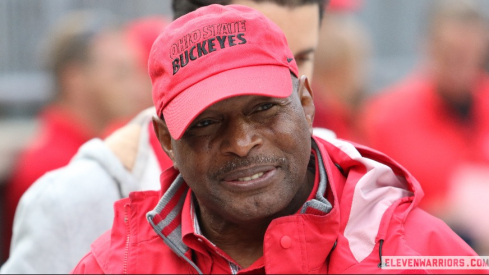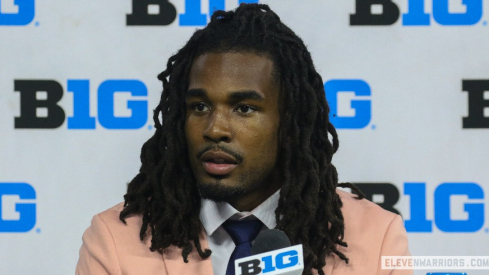
Ohio State reached into its recent past for its strategy to check Sonny Dykes and Tony Franklin’s Cal offense – keep everything in front and come up and tackle, forcing the offense to drive the length of the field. The Buckeyes had some success doing so, but faltered when they deviated from what that strategy required – surrendering explosive plays, that being gains greater than 20 yards.
Cal’s big plays were often a result of poor tackling, a recurring problem in recent seasons. Despite this, the Buckeye defense made numerous stops, particularly in the first quarter, to allow Ohio State to establish a comfortable lead the Buckeyes never surrendered.
Below I examine the defensive game plan against the Bear Raid, why the strategy did and did not succeed and the takeaways for the Ohio State defense moving forward.
The Ghosts of Heacock’s Past
The Ohio State defense had a straightforward strategy to defend Cal’s quick, horizontal passing game. Concede certain underneath throws, make tackles, and force Cal to drive the length of the field. To do so, the Buckeyes eschewed the split safety pattern matching cover 4 they often use against spread offenses for the more traditional single high safety cover 3, a coverage the Buckeyes used sparingly last season.

Ohio State would present Cal with a two high safety look, with CJ Barnett rolling down at the snap with Christian Bryant playing the deep middle. The coaching staff’s goal was to make tackles in front of the back three defenders. The staff mixed this primary coverage with cover 1, cover 2, and quarter quarter half.
If this strategy sounds familiar it should – it was the basic game plan that Jim Heacock employed during his successful tenure as Ohio State’s defensive coordinator. Heacock’s influence should not be surprising, given that he is a consultant to the defense.
To implement this plan against Cal’s 4 and 5 wide receiver sets, Ohio State overwhelmingly played its dime package, with Corey Brown coming in for Curtis Grant. This left Ryan Shazier as the only linebacker. On third and long Ohio State went further, utilizing seven defensive backs. Armani Reeves entered in place of a defensive tackle with Shazier lining up a stand up rush end.

Shazier was highly effective in that role. Look for Ohio State to try and continue to utilize him in this manner on third and long, at least when the coaching staff does not believe another linebacker is needed.
Close but No Cigar
The Buckeye defensive strategy succeeded until it did not. The Buckeyes made several first quarter stops, allowing Ohio State to build a 21-0 lead. But Ohio State then surrendered two touchdowns on plays over 40 yards. This violates the central tenet of the defensive strategy. Putting aside a discussion regarding whether it is the correct strategy (and Jim Heacock’s defenses stopped a lot of good offenses following this formula), once a defense decides to follow that plan it defeats the purpose if the defense is allowing explosive plays.
The first such touchdown was a lapse in coverage. The Buckeyes were in cover 2 and stopped the initial pass routes. Cal’s Jared Goff scrambled, leading Cal Wide Receiver James Grisom to release downfield. Bradley Roby lost track of Grisom, allowing him behind the coverage. Roby compounded the problem with a poor tackle attempt.

Cal’s second touchdown on a jailbreak screen resulted from poor recognition from Ohio State’s defensive backs and excellent execution by Cal. As noted, on third downs, Reeves entered and played in the slot, a position he may not be entirely familiar with. He was slow to react, allowing Cal’s linemen to set their blocks.

As Meyer stated, the Buckeye defensive backs need to trigger on such plays. That is precisely what Bradley Roby does on the same play later in the game, stopping it for no gain.

Going forward, the Buckeyes need more consistent play from their star, Tyvis Powell, to reduce the gains by opposing offenses on wide receiver screens. The star is often responsible for the wide side flat, and he needs to recognize what is coming, beat the block to the spot, and make a play.
Beyond Cal’s scores off breakdowns such as these, Ohio State’s game plan was largely successful against the Bears’ prolific attack. Three of Cal’s four touchdowns came on drives where Cal had an explosive play. The Buckeyes held Cal on two other drives to field goals and limited Cal to .37 points per play, a vindication of the Buckeyes’ strategy. Ohio State also forced three three and outs. The Buckeyes were not going to completely stop an offense running so many plays, but the game plan was to make Cal beat them, a plan undermined at times by big plays.
Where We Stand
Ohio State's defensive performance against Cal should not cause panic, however. Dykes and Franklin had one of the top offenses in college football in recent years and Cal has some talent on offense. Cal will likely score points against every team . Cal deployed a fake punt (with Goff wearing the same number as the punter), a hook and lateral, and other deception plays in an attempt to stay with Ohio State. When an offense is running nearly 100 plays in rapid succession they will inevitably move the football. A defensive’s performance should be measured differently than in a game with 50 plays per side.
The brightest spot for Ohio State is the emergence of depth in the defensive front and backfield, permitting the defensive staff flexibility. Nowhere has that been more important than the emergence of Joey Bosa. It is difficult for a unit that was replacing four starters to lose Tommy Schutt and Adolphus Washington. But Bosa has stepped in and not missed a beat. For a freshman he is physical at the point of attack and has a nose for the football, particularly against the run. When Washington returns the Buckeye coaching staff needs to find ways to get both Bosa and Washington on the field together.
Noah Spence also played another solid game. Spence is always around the quarterback and simply needs to improve his pass rushing moves to increase his sack total. The Buckeyes need Schutt to solidify their depth at nose guard, but when Schutt and Washington return Ohio State has the potential for a deep rotation up front.
As Meyer stated, his team's defensive shortcomings against Cal were primarily a result of mental breakdowns. The Buckeyes had double digit-missed tackles, a number Meyer would like in single digits. This would cut down explosive plays and force offenses to execute. The defense must continue to improve its tackling and recognition, but still has the making of a strong unit by season’s end.

